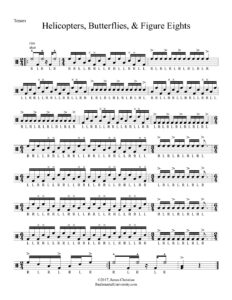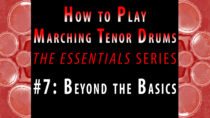The final installment is here: today we go beyond the basics of multi-tenor drumming! So far, we have covered the essential skills every tenor drummer should know. Now I bring you more advanced concepts that are sure to Read more “How to Play Marching Tenor Drums, part 7 of 7: Beyond the Basics”
Tag: scrapes
Multi-Tenor Drum Etude #19: “Fibonacci”
This “nerdy” tenor solo is dedicated to math geeks everywhere! This is multi-tenor drum etude #19 from The Art of Multi-Tenor Drumming. The main theme is derived from the Fibonacci sequence, and it focuses on developing sweeps, a.k.a. scrapes, around the drums.
Here are the performance notes from the book:
I originally thought of titling the next three etudes Sweep Fest #1, Sweep Fest #2, and Sweep Fest #3. (I ultimately settled on that title for etude #21 alone.) The idea was that each of the three etudes would focus on sweep patterns, but they would increase in difficulty. This idea still generally holds true, but a few ideas came to me based on mathematics, and they lent themselves to sweeps quite well. I think this gives the following etudes a very interesting structure, much more interesting than what I would have created if I was simply trying to write a sweep etude from scratch.
I was reading how the Fibonacci sequence is used in the music of Bartók, Debussy, Satie, and others. This gave me the idea to do a few experiments. The main theme of this etude, Fibonacci, is derived from the Fibonacci number sequence. In short, Read more “Multi-Tenor Drum Etude #19: “Fibonacci””
Multi-Tenor Etude #6: “Double Crossed”
Here is a visually exciting tenor solo from The Art of Multi-Tenor Drumming. The book contains 33 multi-tenor etudes, and this is etude #6 entitled “Double Crossed.” As the title suggests, the focus is on developing crossovers.
Here are the performance notes from the book:
This flashy etude utilizes an abundance of crossovers. The first half begins with an 8th note pattern. The second half, beginning with measure 16, utilizes the same pattern with doubles on every note. Both halves feature a repeated section—the first time through at mezzo-forte, the second time at fortissimo. Be careful not to play the mezzo-forte section too loudly; otherwise the contrast will be obscured, or you will be forced to overplay the fortissimo section. Stark dynamic contrast will really help to sell the ideas in this solo. There is a more intricate 16th note sweep section during the last two lines. Take care to aim for the proper beating spots to avoid rims. You may want to review the 16th note doubles section in the rudimental exercises [contained in the book].
Thanks for watching. If you enjoy the video, please “like” it and share it with your friends!
Multi-Tenor Etude #27: “Maze”
Here is the next installment of videos from my book The Art of Multi-Tenor Drumming. In addition to thousands of exercises, the book contains 33 etudes. This is etude #27 entitled “Maze.”
Here are the performance notes from the book:
This etude is dedicated to DCI snare champion, Ken Mazur. His books have done a lot to help me grow in my playing, and they were a great inspiration to me in writing this book. The etudes in this section were largely inspired by the “Rudimental Performance” etudes in his orange book [The Basic Technique of Rudimental Drumming]. In fact, this etude can be played as a duet with the final “Rudimental Performance” etude, or it can be played as a stand-alone solo. If played as a duet, the first two measures are a solo introduction, and the snare part would come in on measure 3. I have always loved the snare etude, and I thought it would be nice to have a tenor version of it. (With the added arounds and sweep patterns, the tenor part is slightly more difficult, but you have to be a pretty good player to play either version well.)
In adapting this etude to tenors, I looked to the Marty Hurley/Lee Hansen snare/tenor duets, such as Phantom of the Phield and Phantom Phrenzy. Of course, Ken Mazur was a student of Marty Hurley, and you can hear Hurley’s influence in Mazur’s writing. The Hurley solos were originally written as stand-alone solos. Later, Lee Hansen (another student of Hurley’s) wrote tenor accompaniments that could be played as either a stand-alone tenor solo or a duet with the snare part. These solos were all written for quads (four drums), and I decided to do the same here.
As you play through this etude, you will find that the structure has a really good sense of momentum, and a lot of different rudiments are incorporated. It’s a lot of fun to play, and there are several rudimental surprises throughout. Whether you play it as an individual solo or as a duet with a good snare drummer, it should thoroughly engage any audience.
I hope you enjoy the video!
Multi-Tenor Etude #11: “Believe It or Not”
At the beginning of the year, I announced that I intended to record a number of the etudes from my book The Art of Multi-Tenor Drumming. There are 33 etudes total, and here is my first video toward that goal. This is etude #11 entitled “Believe It or Not.”
Here are the performance notes from the book:
This lively etude is intended to be a good overview of fundamental skills. The initial theme is presented in the introduction and hinted at throughout the rest of the solo. Each subsequent section works on a specific skill—movement patterns, triplet rolls, crossovers, flams, odd-metered time signatures, tuplets, extended 32nd note rolls, and extended 24th note singles. Finally, the original theme is reprised, concluding with a final challenge of rapid fire dynamic changes. All of this is packed into 34 energetic measures. Younger players should take this at a moderate tempo, as it will serve as a good solo for incorporating fundamental techniques. More advanced players will find it a challenge to take a more lively tempo. The etude works well at a variety of tempos.
I hope you enjoy the video!
Multi-Tenors Exercise: Helicopters, Butterflies, & Figure Eights

Here is a new exercise for marching tenors that focuses on the three most common crossover sweep patterns: helicopters, butterflies, and figure eights.
In case you are unfamiliar with these terms, helicopters are found in measures 2 and 4. Butterflies are found in measures 6 and 8. Figure eights are found in measures 10 and 12. The final pattern, found in measures 14 and 16, is not as common, but it makes logical sense in the context of this exercise. I call the pattern inward figure eights. With all of these patterns, they are presented first with right hand lead and then with left hand lead.
All these sweep patterns are based on the visual “picture” created from their movement when played rapidly. Helicopters look a bit like helicopter blades moving. Butterflies create sort of a butterfly wing shape. Figure eights create an “8” shape. Inward figure eights follow the same motion, but the sweeps move inward instead of outward.
The measures that do not contain sweeps are meant as a groovy check pattern. I find the accent and rim shot patterns more fun to play than a measure of straight singles (or something similarly basic). I suspect most readers will enjoy them more as well.
This exercise is great for all ability levels. Beginner players will want to take each measure very slowly in order to learn these patterns. You may need to start around 80 beat per minute (bpm) on the metronome. Advanced players may be able to treat the exercise in more of a double time fashion, playing in a tempo range of 240 bpm—or faster!
As always, focus on proper playing zones. Avoid rim clicks and aim for 100% accuracy. Maintain even sounding doubles, so that both notes are of equal volume. Enjoy!

